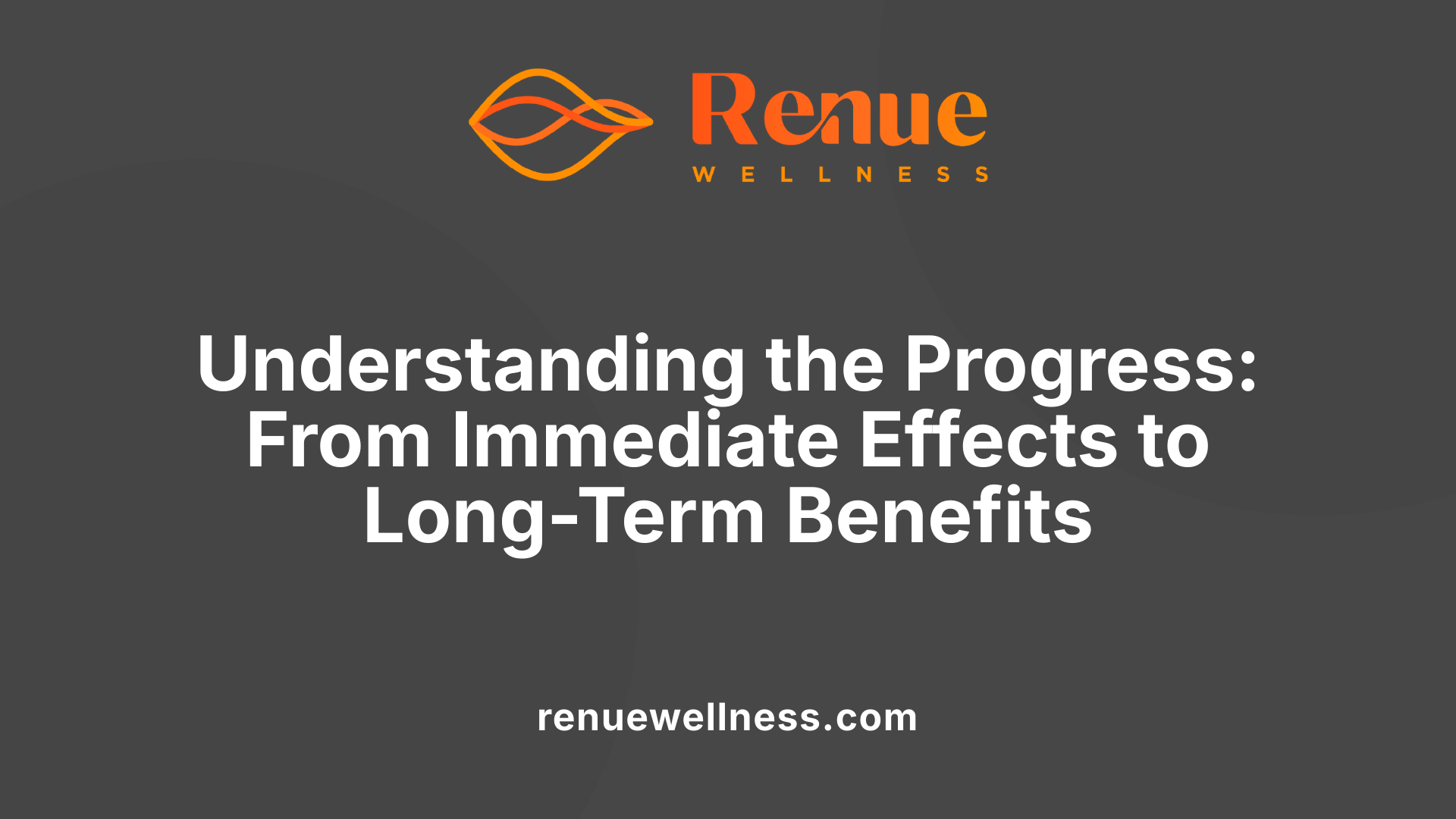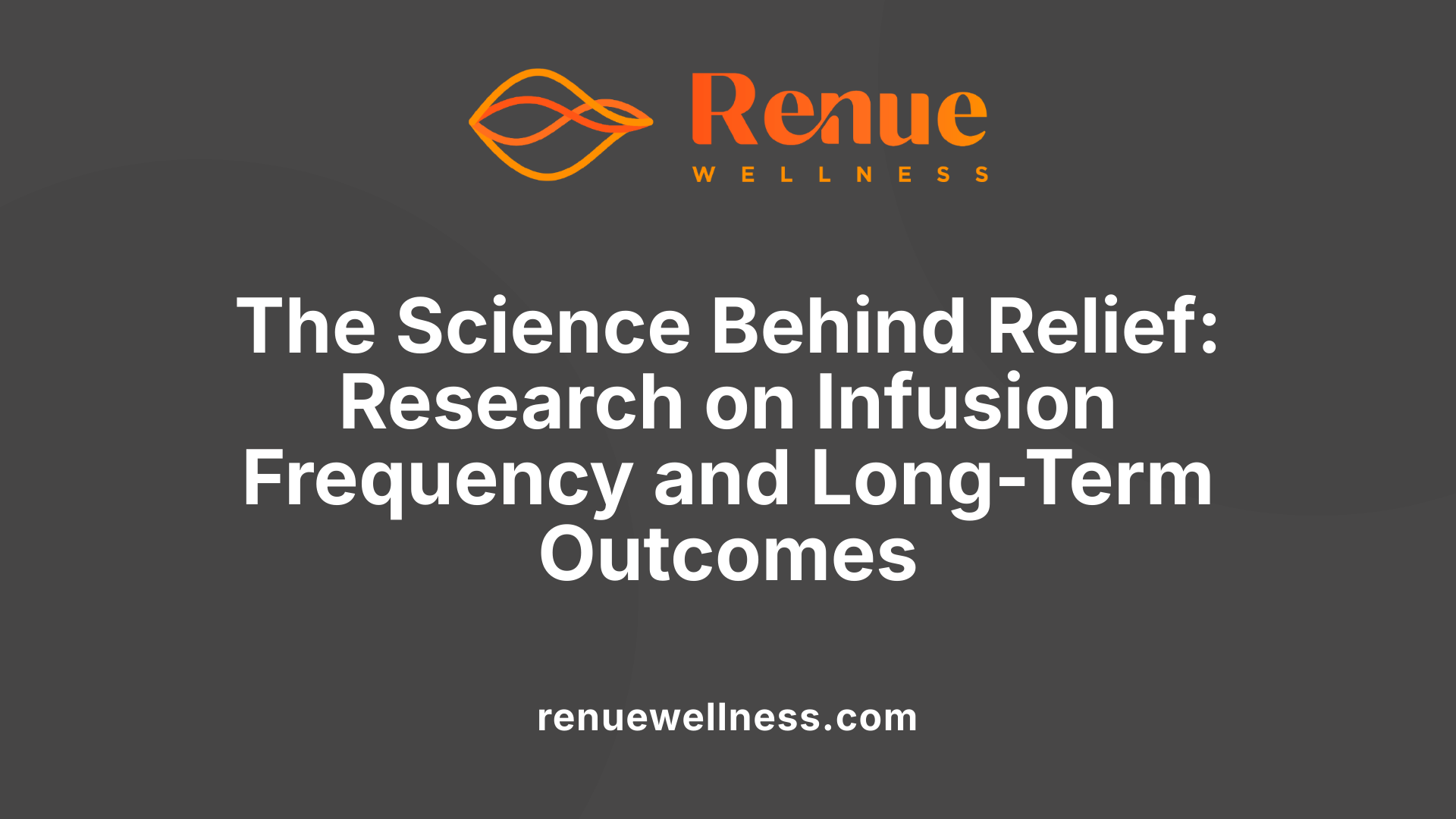How Often Do Patients Experience Relief After Ketamine Infusion?


July 30, 2025
An Overview of Relief Onset and Duration
Ketamine infusion therapy has emerged as a groundbreaking treatment for conditions such as treatment-resistant depression and chronic pain. Its hallmark is delivering rapid relief from symptoms, often within hours or days, and the duration of this relief can vary greatly among patients. This article explores how often, and for how long, patients experience relief following ketamine infusions, considering factors that influence these timeframes, and sharing insights from current research and clinical practice.
The Timeline of Symptom Relief Post-Infusion

What is the typical timeline for patients to experience relief after ketamine infusion?
Most patients begin to notice symptom relief within 24 to 72 hours after their initial ketamine infusion. Some individuals experience immediate effects during or shortly after the session, feeling the therapeutic benefits kick in quickly.
Initially, a single infusion provides only temporary symptom reduction, usually lasting from a few hours to a few days. To achieve more sustained improvement, patients typically undergo a series of six infusions over two to three weeks.
By the third or fourth treatment, many patients identify clearer and more consistent enhancements in mood, energy, and overall well-being. Full benefits often become apparent after completing the entire series, which can range from six to eight infusions.
The duration of relief can vary widely among individuals. Some may experience benefits lasting several weeks or even months, particularly if maintenance infusions are incorporated into their treatment plan.
Ongoing booster sessions scheduled every one to two months help sustain symptom relief for many. The response timeline depends on personal factors such as the severity of the condition, biochemical responses, and individual physiology.
In summary, while some notice early improvements during or immediately after treatment, it’s common for significant and lasting symptom relief to develop over a period of weeks, with continued maintenance necessary to prolong benefits.
Duration of Relief: From Hours to Months

How long does the relief from symptoms last after ketamine treatment?
The duration of symptom relief following ketamine treatment varies widely among individuals. Typically, most patients experience relief from depression, chronic pain, or anxiety within hours to days after an infusion. For many, the initial effect lasts about one to two weeks. However, this can extend to several weeks or even months for people undergoing repeated or maintenance infusions.
A single low-dose ketamine infusion usually provides symptom relief for approximately one week. When doses are repeated over a series of sessions, the effects can accumulate and last longer—sometimes up to three months or more. This extended benefit occurs because repeated doses build up medication levels in the body, promoting neuroplasticity and neural rewiring.
Studies also indicate that longer or more frequent infusions, particularly in a carefully managed treatment plan, can prolong the period of relief. For example, some patients report benefits lasting on average 4 to 6 weeks, and maintenance treatments can sustain these effects. Booster infusions scheduled every 3 to 4 weeks are common to prevent relapse.
It’s important to note that the relief is not permanent—a significant number of patients relapse within two weeks if no further treatment is administered. This highlights the temporary nature of ketamine’s effects. Ongoing management with mental health or pain specialists is crucial to maintain the benefits.
Overall, while ketamine offers rapid and substantial symptom relief, the duration of benefits depends on individual factors such as biology, condition severity, and treatment regimen. Long-term, continuous treatment or booster infusions are often necessary for sustained improvement.
| Duration of Relief | Typical Timeframe | Notes |
|---|---|---|
| Single infusion | 1 day to 2 weeks | Variable, often about 1 week |
| Repeated infusions | Several weeks to months | Accumulating benefits with ongoing treatment |
| Maintenance infusions | Every 3-4 weeks | To sustain long-term effects |
In conclusion, the relief from symptoms after ketamine treatments ranges from hours to months. Most patients find that ongoing infusions are necessary to maintain the improvements, emphasizing the importance of personalized treatment plans.
Factors Shaping Onset and Length of Relief

What factors influence the onset and duration of relief from ketamine infusions?
The timing and length of pain or mood relief after ketamine infusions depend on several critical factors, including how the drug is administered, individual biological differences, and the underlying mechanisms of ketamine’s action.
Dosing and route of administration play a significant role. Higher doses delivered intravenously (IV) tend to produce a rapid onset of effects, often within minutes, with relief lasting from a few hours to several days. This method is common in clinical settings for depression and pain management. In contrast, lower doses administered through routes such as intranasal (like esketamine) or oral routes often have a slower onset, sometimes taking hours, but the effects can last longer.
The individual’s unique metabolism and biology also influence how long ketamine’s effects last. Factors such as age, genetic makeup, liver function, and whether the patient is taking other medications affect how quickly ketamine is absorbed, processed, and eliminated from the body. Faster metabolism can shorten the duration of benefit, whereas slower metabolism might prolong it.
The mechanisms behind ketamine’s effects are complex, involving neuroplasticity and receptor activity, particularly at NMDA receptors and the subsequent pathways that promote the formation of new neural connections. These processes can influence how quickly relief begins and how long it lasts. For instance, repeated infusions can build up medication levels in the system, extending the period of relief.
Overall, the onset of benefits can occur within hours to days, while the duration ranges from a few days to several months, heavily dependent on dosage, administration route, biological factors, and the underlying condition. Tailoring treatment to individual needs and responses ensures the best possible outcomes, with some patients requiring ongoing booster infusions to maintain relief.
| Factor | Influence on Onset and Duration | Additional Details |
|---|---|---|
| Route of administration | IV (intravenous) provides rapid onset, longer effects; nasal/oral is slower but longer-lasting | IV often within minutes; nasal/inhaled may take hours |
| Dose | Higher doses typically increase intensity and short-term effects | Requires careful medical supervision to avoid side effects |
| Individual metabolism | Faster metabolism shortens effect; slower prolongs it | Includes age, liver function, genetics, medications |
| Biological response | Neuroplasticity pathways modulate lasting relief | Repeated dosing can build effects through neural changes |
Understanding these factors helps optimize treatment plans to maximize benefits and minimize side effects, ensuring patients receive effective and personalized care.
Patient Responses and Variability in Relief
How soon can patients expect to experience symptom improvement after ketamine treatment?
Many individuals report feeling relief from symptoms such as depression, anxiety, or chronic pain within hours to days following a ketamine infusion. Some patients notice a rapid change, experiencing mood elevation or pain reduction as early as one hour after their first dose. Typically, the peak of the effects occurs around 24 hours, with improvements lasting anywhere from a few days to a week or more.
This immediate response is one of ketamine’s hallmark benefits, especially compared to traditional medications that may take weeks to show results. After completing a series of infusions—usually around six over a few weeks—many patients experience more sustained improvements that can last for several months.
The duration and clarity of relief significantly depend on individual factors, including biology, the severity of the condition, and how the treatment is administered. Some patients find that their symptoms diminish quickly and remain stable with maintained treatment, while others might experience relief that diminishes sooner, requiring booster infusions every few weeks.
Studies and clinical experiences indicate these variations are quite normal, emphasizing the importance of personalized treatment planning. With ongoing care and sometimes combined therapy such as medications or psychotherapy, patients often find that they can maintain gains achieved through ketamine infusions.
Factors affecting response times and duration
Many factors influence how quickly and how long patients feel the benefits of ketamine. Individual biology, such as genetics and brain chemistry, plays a crucial role. The specific condition being treated also impacts outcomes; for example, depression and chronic pain can respond differently.
Response times may also vary based on the treatment regimen, including the number of infusions, dosage, and whether maintenance sessions are incorporated. Patients who adhere to the recommended series often see better and more lasting effects.
Psychological and physiological influences
Psychological factors, such as expectations and mental health status, can influence outcomes. A strong therapeutic alliance with clinicians tends to enhance the treatment experience. Physiological attributes like age, overall health, and the presence of other medical conditions can also impact response times and the duration of relief.
Moreover, some individuals might experience side effects such as dissociation, nausea, or elevated blood pressure, which typically resolve soon after treatment. These effects do not usually interfere with the benefits and are closely monitored during treatment.
In summary, ketamine offers a rapid onset of symptom relief for most patients, with variations driven by biological and psychological factors. Ongoing treatment and personalized care are essential for maximizing and maintaining benefits.
Research Evidence on Relief Duration and Treatment Frequency

What does research say about the frequency and duration of ketamine infusions for maintaining relief?
Studies on ketamine infusion therapy reveal that the duration of pain and depression relief varies widely among individuals, depending on treatment specifics and personal biology. A single infusion often provides relief for a few days to a few weeks. Most patients experience about one to two weeks of symptom improvement, with some reporting benefits lasting up to three days.
Repeated infusions, however, can extend the period of relief. For example, a series of six to eight infusions over several weeks often results in more sustained improvements. These repeats are not just for immediate symptom relief but also serve to build up medication levels, prolonging positive effects.
Research shows that maintenance ketamine treatment—meaning booster infusions scheduled every 3-4 weeks—can be effective at preventing relapse. Some protocols involve infusions once a week after the initial series, or less frequently based on individual response. These maintenance schedules are supported by studies indicating that ongoing treatments are more effective at sustaining improvements than just initial high-dose courses.
While some evidence suggests long-term benefits with regular maintenance therapy, the optimal scheduling remains personalized. Concerns about potential long-term side effects, such as cognitive impacts or dependence, must be balanced against the benefits. Therefore, continuous monitoring and tailored treatment plans are recommended.
In summary, current research highlights the importance of individualized schedules—initial series of infusions followed by periodic booster doses—to optimize the durability of relief from depression and pain, all under careful medical supervision.
Monitoring and Side Effects During and After Infusions

What can patients typically expect in terms of the effects and timeline of relief after a ketamine infusion?
Patients usually experience rapid improvements in symptoms, especially in depression, often within hours or days after receiving a ketamine infusion. During the treatment itself, many individuals report feelings of relaxation, detachment, floating sensations, or a trance-like state, which are common and transient. Immediately following the infusion, some may feel sleepy, disoriented, or experience mild nausea. Visual distortions such as double vision or illusion-like experiences can also occur. These effects typically last only a few hours and tend to resolve quickly. Because of this, patients are generally advised to schedule someone to drive them home and avoid operating machinery for at least 12-24 hours. The full benefits from ketamine therapy usually become apparent after completing a series of infusions, commonly around the third or fourth session. Significant symptomatic relief often appears by the fifth or sixth infusion, marking the culmination of the initial treatment protocol. The timeline for sustained relief varies widely among individuals. Some patients report benefits lasting only a few days, while others experience relief that persists for weeks or even months. Factors influencing this variability include individual physiology, severity of the condition, dosage, and treatment frequency. Many clinicians recommend combining ketamine infusions with psychological support, such as therapy or mindfulness practices, to help maintain and enhance the treatment effects over time.
Expected mild side effects
Most patients tolerate ketamine infusions well and report only mild and short-lived side effects. Common reactions include feelings of sleepiness, dizziness, visual changes like double vision, mild hallucinations, or emotional sensitivity. Nausea may also occur but can usually be managed with supportive medications. Some patients experience an elevated blood pressure during the infusion, which generally resolves once the treatment ends. Side effects typically last no longer than a few hours, with most resolving within the first four hours post-treatment.
Management of adverse events
In clinical settings, healthcare providers monitor patients closely during and after infusions to manage any adverse effects promptly. For nausea, anti-nausea medications are often administered in advance. Elevated blood pressure is carefully observed, and if necessary, managed with medication or adjustments to infusion speed. In the rare event that a patient experiences significant discomfort or adverse reactions, treatment can be paused or stopped altogether. Minor visual distortions or dissociative experiences are expected and usually benign. Most side effects are transient and resolve quickly, making ketamine infusion a safe option when administered in supervised medical environments.
Importance of medical supervision
Supervised medical oversight is crucial for ensuring patient safety during ketamine therapy. Healthcare providers assess patient suitability, tailor dosing protocols, and monitor vital signs throughout the infusion process. Patients are typically observed for a period after the treatment to ensure side effects are manageable and to provide support if any issues arise. The provider also discusses post-treatment care, including activity restrictions and follow-up plans. Close supervision minimizes risks such as increases in blood pressure, nausea, or dissociation and ensures a safe, comfortable treatment experience. It also allows for quick intervention should any adverse events occur, optimizing the overall safety and effectiveness of ketamine therapy.
Safety, Tolerance, and Long-Term Considerations
What are the expected outcomes and effectiveness of ketamine therapy for pain and depression?
Ketamine therapy has shown promising results in rapidly reducing symptoms of depression and chronic pain. Many patients notice improvements within hours or days after treatment, with some experiencing relief lasting from a few days to several weeks or even months. For depression, most benefit from a series of infusions over two to three weeks, with sustained effects that can last around three months or longer, especially when followed by maintenance infusions scheduled every 3-4 weeks.
In cases of chronic pain, longer infusions or repeated doses can extend relief for months. Effectiveness varies among individuals due to factors like biology and the specific condition being treated. While the immediate results are often positive, not everyone experiences long-lasting relief, emphasizing the need for ongoing treatment and follow-up care.
Overall, ketamine is considered a valuable option for those with treatment-resistant depression and certain pain syndromes. Its quick action contrasts with traditional therapies that often take weeks to work, offering hope for timely symptom relief. Despite its benefits, further research is essential to fully understand the long-term benefits, potential risks, and the precise mechanisms involved.
Common side effects
Most patients tolerate ketamine infusion therapy well. Common transient side effects include feelings of sleepiness, dizziness, visual distortions such as double vision, mild hallucinations, dissociation, nausea, and numbness. These effects usually last for a few hours following the infusion. Some individuals may experience a temporary increase in blood pressure and heart rate during treatment, which typically resolves afterward.
Potential risks and organ damage
Concerns about long-term risks from clinical ketamine use do exist, but they are generally associated with recreational or high-dose misuse rather than supervised medical treatment. Repetitive sessions might carry a risk of organ-related issues, such as liver enzyme elevations and urological problems. Extended or high-dose infusions in non-clinical settings have been linked to bladder damage and cognitive impairment.
Studies indicate that organ damage is less common when ketamine is administered under strict medical supervision, with careful monitoring of cardiac and liver function. It is crucial to adhere to recommended dosing regimens to minimize adverse effects.
The importance of clinical setting and monitoring
Ketamine therapy is safest when delivered in a controlled clinical environment. Medical professionals closely monitor vital signs, mental state, and overall health during and after infusions. Patients should be advised to arrange transportation after sessions, as drowsiness and dizziness are common.
Monitoring helps identify adverse reactions early, reducing the risk of complications. Follow-up includes assessments of mental health, physical health, and ongoing symptom management. Combining ketamine with other therapies like psychotherapy and medication management can help sustain benefits and reduce relapse.
| Aspect | Details | Additional Notes |
|---|---|---|
| Side effects | Sleepiness, dizziness, visual distortions, dissociation, nausea | Usually brief, lasting hours |
| Organ risks | Liver, urinary tract damage with repeated high doses | More common with recreational use |
| Monitoring | Vital signs, mental state, physical health | Essential for safety in clinical settings |
| Long-term use risks | Tolerance, dependence, cognitive effects | Minimized under medical supervision |
Ketamine continues to be a valuable tool in managing difficult conditions like treatment-resistant depression and chronic pain. With proper medical oversight and ongoing evaluation, the potential risks can be mitigated, making it a safe option for many patients seeking rapid relief.
Final Thoughts on Relief Durations and Expectations
In summary, ketamine infusion therapy offers a promising avenue for rapid symptom relief in depression and pain conditions, with many patients experiencing noticeable improvements within hours to days. The duration of relief is highly individual, generally lasting from one to several weeks, and can be extended through maintenance infusions tailored to the patient's response. Variability in response times and relief longevity necessitates personalized treatment plans and ongoing monitoring by healthcare professionals. While the therapy is generally safe under medical supervision, awareness of potential side effects and risks is essential. As ongoing research continues to refine treatment protocols, patients and clinicians can expect increasingly effective strategies to optimize the duration and quality of relief, offering hope to those with treatment-resistant conditions.
References
- How Long Does Ketamine Pain Relief Last? A Simple Guide
- Ketamine Treatment: How often and how long - Principium Psychiatry
- Ketamine Clinic | Psychiatry - Michigan Medicine
- How Long Does Ketamine Pain Relief Last | Bespoke Treatment
- Risks and benefits - Interventional Psychiatry Service - Oxford Health
- Ketamine Infusion Therapy: Understanding the Duration of Treatment
- Ketamine for chronic pain: risks and benefits - PMC - PubMed Central
- Ketamine Therapy Timeline: How Long Should You Wait for Relief?
Recent Posts
Conditions Treated
AnxietyDepressionOCDPTSDPostpartum DepressionPain ManagementSubstance AbuseSuicidal IdeationOur Location


